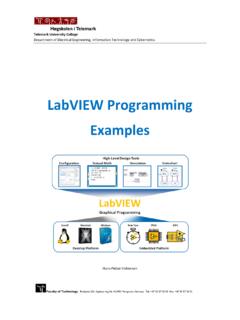Transcription of javax.swing.JOptionPane - Kansas State University
1 The Java API class has facilities for creating a dialog box that can appear on the computer's desktop to request input from or display messages to the user. Here are three easy dialog boxes provided by the class. Three Types of joptionpane Dialog Boxes Dialog Box Method Description/Example Prompts user for input Input Dialog showInputDialog Displays a message to the user Message Dialog showMessageDialog Asks the user for his or her consent Confirm Dialog showConfirmDialog Page 1. Message Dialogs joptionpane Methods to Display a Message Dialog static void showMessageDialog( Component win, String message, String title, int messageType, Icon icon ). // Displays a message dialog with the specified message, // title, message type and icon.
2 Static void showMessageDialog( Component win, String message, String title, int messageType ). // Displays a message dialog with a given message, title and // message type, which indicates which icon to display. static void showMessageDialog( Component win, String message ). // Displays a message dialog titled "Message" and showing the // default icon. Parameters for showMessageDialog Parameter Description A reference to your application's desktop window; if your Component win application doesn't have one, pass it the null pointer. String message The message you want displayed to the user. String title The title that is to be displayed in the title bar of the dialog box. An integer code indicating the type of message to be displayed.
3 Int messageType This is used primarily to pick from among a preselected set of icons. Icon icon An icon to display within the dialog box. The dialog box is modal, meaning that the execution of the Java program is blocked until the user's interaction with the box is completed, which happens when the user clicks the OK button or the Close button ( ). Page 2. Example The Java application below displays the message dialog shown at right. The following table shows the five arguments passed to the method and why. Arguments Passed to showMessageDialog and Why Argument Why null The application has no desktop window. msg Contains the message. ttl Contains the title. 0 Doesn't matter since I'm passing the icon I want to use.
4 Icon The icon I want to display within the dialog box. 1 import static *;. 2. 3 public class MyApp 4 {. 5 public static void main( String [] args ). 6 {. 7 Icon icon = new ImageIcon( " " );. 8 String ttl = "Essent";. 9 String msg = "Electronic music for the 21st century";. 10 showMessageDialog( null, msg, ttl, 0, icon );. 11 }. 12 }. Page 3. If you don't want to go to the trouble of creating your own icon, the second overloaded showMessageDialog method allows you to choose an icon from among a preselected set. You do this by passing an integer code as the fourth argument. It is not considered good programming sportsmanship to require fellow programmers to remember the meanings of specific integer codes.
5 Instead, seasoned programmers provide ease- of-use constants, which are predefined constant identifiers that his or her fellow programmers can pass as argument values. In the Java API, ease-of-use constants are usually defined as static fields within the class. A list of static fields within the that are valid for the message type parameter is shown on the next page. To use these constants, simply pass them as the fourth argument to the showMessageDialog method. Example These Java statements display the first message dialog shown in the table on the next page. 1 import static *;.. 2 showMessageDialog( null, "Message", "Title", ERROR_MESSAGE );. The third overloaded showMessageDialog method is very short and uses a default title and icon.
6 Example The Java statements below display the output dialog shown at right. 1 String msg = "Susie sells sea shells by the sea shore";. 2 ( null, msg );. Page 4. joptionpane Ease-Of-Use Constants that Specify Message Types Constant Identifier Meaning /Example Displays an error icon static int ERROR_MESSAGE. Displays an information icon static int INFORMATION_MESSAGE. Doesn't display any icon static int PLAIN_MESSAGE. Displays a question mark icon static int QUESTION_MESSAGE. Displays a warning message icon static int WARNING_MESSAGE. Page 5. Input Dialogs joptionpane Methods to Display an Input Dialog static String showInputDialog( Component win, String prompt, String title, int messageType ). // Displays a dialog requesting input from the user // with the given prompt message, title and message type.
7 Static String showInputDialog( Component win, String prompt, String defaultInput ). // Displays a dialog requesting input from // the user with the given prompt and default input. static String showInputDialog( Component win, String prompt ). // Displays a dialog requesting input from // the user with the given prompt. static String showInputDialog( String prompt, String defaultInput ). // Displays a dialog requesting input from // the user with the given prompt and default input. static String showInputDialog( String prompt ). // Displays a dialog requesting input from // the user with the given prompt. Parameters for showInputDialog Parameter Description If this argument is present, it must be a reference to a GUI.
8 Component within your application. The input dialog is displayed Component win centered over the component. If this argument is absent, the input dialog is centered over the desktop. String prompt The prompt message you want displayed to the user. String title The title that is to be displayed in the title bar of the dialog box. An integer code indicating the type of message as explained for int messageType showMessageDialog. String defaultInput A value to appear in the dialog as a default input value. Page 6. Example The Java application below displays the message dialog shown at right. 1 import static *;. 2. 3 public class MyApp 4 {. 5 public static void main( String [] args ). 6 {. 7 String prompt = "Enter 'yes' to confirm deletion".}}
9 8 String title = "Warning";. 9 String input = showInputDialog 10 ( null, prompt, title, WARNING_MESSAGE );. 11 }. 12 }. Example These statements display this input dialog. 1 String prompt = "Enter your birthday";. 2 String input = showInputDialog( prompt, "mm/dd/yyyy" );. Example This statement displays this input dialog. 1 String input = showInputDialog( "Enter your name" );. Page 7. An input dialog is modal, blocking the Java program until the user's interaction with the box is completed, which happens as the following table explains: The Effect of User Actions on an Input Dialog Box User Action Effect Clicks the OK button with the mouse A String object is returned containing Presses the Enter key on the keyboard whatever string is in the dialog's text field Clicks the Cancel button A null pointer is returned Clicks the Close button ( ).
10 Example This String input = showInputDialog( "Enter your name" );. statement: Displays this dialog: If the user types within the text field and clicks OK or presses Enter, any contents of the text field is placed into a String object and its reference placed into variable input. input String object Richard Milhous nixon Page 8. If the user clicks OK or presses Enter with nothing in the text box, a String object containing the null string is returned. input String object If the user clicks Cancel or Close (no matter what's in the text field), the null pointer is returned. input null Page 9. Confirm Dialogs joptionpane Methods to Display a Confirm Dialog static int showConfirmDialog( Component win, String message, String title, int optionType, int messageType, Icon icon ).



